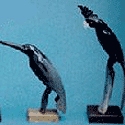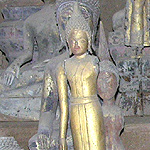Horn as a raw material is available almost everywhere across the sub-continent. Craftspersons use the grain of the material and the variations in colour to great advantage. Buffalo, bullock and bull horn carving is carried out in Trivandrum, Trichur, Kasaragod, Ernakulam, and Cochin. Palakkad district. Buffalo horn is commonly used due to its large size and tapered base; bullock horns are smaller and used for crafting smaller objects; while bull horns are only seldom used since it is hollow and suitable only for carving specific parts that require their use for instance the tail of the peacock.
The process begins with the upper layers of the horn being stripped off with chisels; the desired shape is marked with chalk, and the extraneous surfaces are sawn or chiseled off. The horn may also be moulded to the desire shape by softening it through heating; it is then tempered with water and polished. The horn is sandpapered and rubbed with the spine of a soaked leaf from the kadaplaava or small jackfruit tree this process induces a milky liquid to form and settle on the surface of the horn. A black, sooty paste-prepared by burning a palm leaves or panayola and mixing the residual ash with water – is rubbed onto the horn until its surface heats up doe to friction and the paste is absorbed into the grainy structure of the horn and lends it a fine sheen. Textures are created by applying a mixture of chalk and adhesive to etched patterns; the polished areas gleam while the etched areas catch colour. Common products include models of birds and animals, toy furniture, and miniature snake boats. Utilitarian items like paper weights, vases, buttons, trays, little boxes, pen stands, lamps, cigarette cases, and ashtrays are also made. Kerala cranes are particularly famous as are animals like elephants and tigers. Till the ban on ivory Kerala was reputed for its ivory carving and Trivandrum was the most important centre. Earlier the products made were images of deities and sacred animals. The ivory carvers have now shifted to horn, bone and wood and they continue to carving mythological figures and natural objects. The more common representations are of Shiva as Nataraja, Shiva-Parvati, Ganesh, Subrahmanya, Vishnu Sarasvathi, and Lakshmi. Carving is done with a chisel very gently to avoid damage. Apart from carving, designs are also etched on to the surface. Floral or geometrical patterns, birds, animals, and jungle scenes are carved in bass relief. Another specialty of Kerala is a set of over 100 miniature elephants sealed in a small shell with a diameter of 0.5 cm. Kerala also had a rich tradition of ivory painting. The area to be painted was smoothened with sandpaper and the outline of the picture was sketched on it in pencil. It was pierced with a needle and water colours applied on the surface with a pointed brush so that the colour penetrated the little holes. The tools used include the electric motor and needles.
Gallery
YOUR VIEWS
PRACTITIONERS: INDIA
Access 70,000+ practitioners in 2500+ crafts across India.
BIBLIOGRAPHY
10,000+ listings on arts, crafts, design, heritage, culture etc.
GLOSSARY
Rich and often unfamiliar vocabulary of crafts and textiles.
SHOP at India InCH
Needs to be written.






